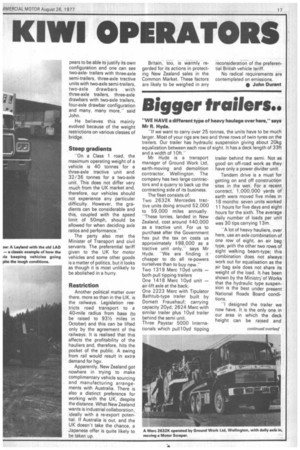ZEAL IS A MUST Fi KIWI OPERATORS
Page 18

Page 19

If you've noticed an error in this article please click here to report it so we can fix it.
VEHICLES last longer in New Zealand: the Kiwis make them last longer.
So the New Zealand market — three million people in an area about the same as that of the British Isles — calls for well-made lorries. And spares back-up is especially important in those conditions, This much is obvious, but there is nothing to compare with a visit to discover the less obvious and whys and wherefors.
John Bradley, export sales manager for Seddon Atkinson, has recently returned from
visiting the North and South Islands. "The fact that we are part of the International Harvester group gives us a ready-made network in New Zealand; all we had before was one distributor," he told me. -And IH has an assembly plant in Christchurch.
Good going "This year, we'll ship about 80 vehicles — good going for the New Zeland market on past experience. In fact, we are supplying Cummins in, increasing quantities; in January '78, we'll supply three-axle 400 Series powered by the Cummins 290. We will use Hendrickson suspension."
John went to New Zealand with a Society of Manufacturers and Motor Traders tour sponsored by the British Overseas Trade Board. It was a return mission to one made to Britain last year by 15 major lorry and bus operators from over there.
As many strikes
Even on a commonplace level, visits between parties from our two countries clear up misconceptions. New Zealanders who have been to Britain know we don't suffer from continuous strikes. And visitors to New Zealand find they have at least as many strikes as we do.
The rate of inflation is about the same in both countries. But in transport there are many differences.
Imports from the UK have a duty of 61/4 per cent levied for any vehicles built up. On top of this duty, together with the associated shipping costs, landing costs and local assembly, there is a sales tax on all vehicles of 40 per cent. This virtually means that, to an operator, vehicle price is double what it would be in the UK. Hence the long first-owner vehicle life in New Zealand — usually eight years or longer.
Special items
The problems, so far, then, appear to be: communication; small market; and high-priced spares because their old vehicles call for small runs for special items.
So much for the supply angle, but what about operation? "Each different type of road transport operation ap
pears to be able to justify its own configuration and one can see two-axletrailers with three-axle semi-trailers, three-axle tractive units with two-axle semi-trailers, two-axle drawbars with three-axle trailers, three-axle drawbars with two-axle trailers, four-axle drawbar configuration and many, many more," said John.
He believes this mainly evolved because of the weight restrictions on various classes of bridge.
Steep gradients
"On a Class 1 road, the maximum operating weight of a vehicle is 40 tonnes for a three-axle tractive unit and 32/36 tonnes for a two-axle unit. This does not differ very much from the UK market and, therefore, our vehicles should not experience any particular difficulty. However, the gradients can be considerable and this, coupled with the speed limit of 50mph, should be allowed for when deciding axle ratios and performance."
The party also met the Minister of Transport and civil servants. The preferential tariff given to the UK for motor vehicles and some other goods is a matter of politics, but it looks as though it is most unlikely to be abolished in a hurry.
Restriction
Another political matter over there, more so than in the UK, is the railways. Legislation restricts road transport to a 40-mile radius from base (to be raised to 931/2 miles in October) and this can be lifted only by the agreement of the railways. It is realised that this affects the profitability of the hauliers and, therefore, hits the pocket of the public. A swing from rail would result in extra demand for hgv.
Apparently, New Zealand got nowhere in trying to make complimentary vehicle sourcing and manufacturing arrangements with Australia. There is also a distinct preference for working with the UK, despite the distance. What New Zealand wants is industrial collaboration,. ideally with a re-export potential. If Australia is out, and the UK doesn't take the chance, a .Japanese offer is quite likely to be taken up.
Britain, too, is warmly regarded for its actions in protecting New Zealand sales in the Common Market. These factors are likely to be weighed in any reconsideratio-n. of the preferential British vehicle tariff.
No radical requirements are contemplated on emissions.
• John Durant












































































